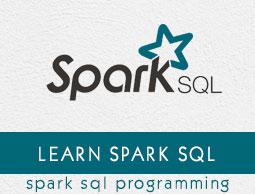Spark SQL - DataFrames
A DataFrame is a distributed collection of data, which is organized into named columns. Conceptually, it is equivalent to relational tables with good optimization techniques.
A DataFrame can be constructed from an array of different sources such as Hive tables, Structured Data files, external databases, or existing RDDs. This API was designed for modern Big Data and data science applications taking inspiration from DataFrame in R Programming and Pandas in Python.
Features of DataFrame
Here is a set of few characteristic features of DataFrame −
Ability to process the data in the size of Kilobytes to Petabytes on a single node cluster to large cluster.
Supports different data formats (Avro, csv, elastic search, and Cassandra) and storage systems (HDFS, HIVE tables, mysql, etc).
State of art optimization and code generation through the Spark SQL Catalyst optimizer (tree transformation framework).
Can be easily integrated with all Big Data tools and frameworks via Spark-Core.
Provides API for Python, Java, Scala, and R Programming.
SQLContext
SQLContext is a class and is used for initializing the functionalities of Spark SQL. SparkContext class object (sc) is required for initializing SQLContext class object.
The following command is used for initializing the SparkContext through spark-shell.
$ spark-shell
By default, the SparkContext object is initialized with the name sc when the spark-shell starts.
Use the following command to create SQLContext.
scala> val sqlcontext = new org.apache.spark.sql.SQLContext(sc)
Example
Let us consider an example of employee records in a JSON file named employee.json. Use the following commands to create a DataFrame (df) and read a JSON document named employee.json with the following content.
employee.json − Place this file in the directory where the current scala> pointer is located.
{
{"id" : "1201", "name" : "satish", "age" : "25"}
{"id" : "1202", "name" : "krishna", "age" : "28"}
{"id" : "1203", "name" : "amith", "age" : "39"}
{"id" : "1204", "name" : "javed", "age" : "23"}
{"id" : "1205", "name" : "prudvi", "age" : "23"}
}
DataFrame Operations
DataFrame provides a domain-specific language for structured data manipulation. Here, we include some basic examples of structured data processing using DataFrames.
Follow the steps given below to perform DataFrame operations −
Read the JSON Document
First, we have to read the JSON document. Based on this, generate a DataFrame named (dfs).
Use the following command to read the JSON document named employee.json. The data is shown as a table with the fields − id, name, and age.
scala> val dfs = sqlContext.read.json("employee.json")
Output − The field names are taken automatically from employee.json.
dfs: org.apache.spark.sql.DataFrame = [age: string, id: string, name: string]
Show the Data
If you want to see the data in the DataFrame, then use the following command.
scala> dfs.show()
Output − You can see the employee data in a tabular format.
<console>:22, took 0.052610 s
+----+------+--------+
|age | id | name |
+----+------+--------+
| 25 | 1201 | satish |
| 28 | 1202 | krishna|
| 39 | 1203 | amith |
| 23 | 1204 | javed |
| 23 | 1205 | prudvi |
+----+------+--------+
Use printSchema Method
If you want to see the Structure (Schema) of the DataFrame, then use the following command.
scala> dfs.printSchema()
Output
root
|-- age: string (nullable = true)
|-- id: string (nullable = true)
|-- name: string (nullable = true)
Use Select Method
Use the following command to fetch name-column among three columns from the DataFrame.
scala> dfs.select("name").show()
Output − You can see the values of the name column.
<console>:22, took 0.044023 s
+--------+
| name |
+--------+
| satish |
| krishna|
| amith |
| javed |
| prudvi |
+--------+
Use Age Filter
Use the following command for finding the employees whose age is greater than 23 (age > 23).
scala> dfs.filter(dfs("age") > 23).show()
Output
<console>:22, took 0.078670 s
+----+------+--------+
|age | id | name |
+----+------+--------+
| 25 | 1201 | satish |
| 28 | 1202 | krishna|
| 39 | 1203 | amith |
+----+------+--------+
Use groupBy Method
Use the following command for counting the number of employees who are of the same age.
scala> dfs.groupBy("age").count().show()
Output − two employees are having age 23.
<console>:22, took 5.196091 s
+----+-----+
|age |count|
+----+-----+
| 23 | 2 |
| 25 | 1 |
| 28 | 1 |
| 39 | 1 |
+----+-----+
Running SQL Queries Programmatically
An SQLContext enables applications to run SQL queries programmatically while running SQL functions and returns the result as a DataFrame.
Generally, in the background, SparkSQL supports two different methods for converting existing RDDs into DataFrames −


